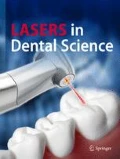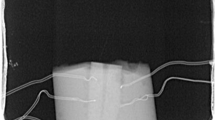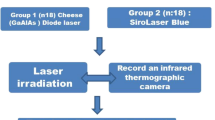Abstract
Aim
Avoiding temperature rise in the periodontal ligament during endodontic laser application is crucial. This study aims to validate the safety of a dual wavelength laser endodontic protocol on the periodontal ligament when cleaning and debriding curved root canals.
Methods
8 human curved root canals were prepared using the reciproc system and stored in thymol solution until the experiment was conducted. The samples were placed in a 37 °C water bath to mimic the body temperature. The dual wavelength laser (Er,Cr:YSGG, 2 W, 20 Hz, 50 μs, 80 Water, 30 Air and diode 940 nm 2 W, 50% duty cycle) was applied in each canal for one cycle. The thermal changes on the outer surface of the root were measured in the cervical, middle and apical thirds of the canal. The recorded measurements were descriptively analysed.
Results
None of the irradiated samples exhibited a temperature rise over 47 °C on the outer surface of the root canal. Contrarily, a temperature drop on the outer surface was recorded.
Conclusion
The dual wavelength laser Er,Cr:YSGG 2 W, 20 Hz, 50 μs, 80 Water, 30 Air and diode 940 nm, 2 W, 50% duty cycle is a safe tool to be used in debriding and cleaning curved root canals.
Similar content being viewed by others
References
Walton RE, Rivera EM (2002) Cleaning and shaping. In: Walton RE, Torabinejad M (eds) Principle and practice of Endodontics, 3rd edn. W.B. Saunders Company, Philadelphia, p 207
Baumgartner JC (2002) Endodontic microbiology. In: Walton RE, Torabinejad M (eds) Principle and practice of Endodontics, 3rd edn. W.B. Saunders Company, Philadelphia, pp 283–287
Violich DR, Chandler NP (2010) The smear layer in endodontics - a review. Int Endod J 43:2–15. https://doi.org/10.1111/j.1365-2591.2009.01627.x
Mozo S, Llena C, Forner L (2012) Review of ultrasonic irrigation in endodontics: increasing action of irrigating solutions. Med Oral Patol Oral Cir Bucal 17(3):e512–e516. https://doi.org/10.4317/medoral.17621
Wong DTS, Cheung GSP (2014) Extension of bactericidal effect of sodium hypochlorite into dentinal tubules. J Endod 40:825–829. https://doi.org/10.1016/j.joen.2013.09.045
Vatkar NA, Hegde V, Sathe S (2016) Vitality of enterococcus faecalis inside dentinal tubules after five root canal disinfection methods. J Conserv Dent 19(5):445–449. https://doi.org/10.4103/0972-0707.190019
Cheng X, Chen B, Qiu J, He W, Lv H, Qu T, Yu Q, Tian Y (2015) Bactericidal effect of Er:YAG laser combined with sodium hypochlorite irrigation against enterococcus faecalis deep inside dentinal tubules in experimentally infected root canals. J Med Microbiol 65(2):176–187. https://doi.org/10.1099/jmm.0.000205
Gutknecht N, Al-Karadaghi TS, Al-Maliky MA, Conrads G, Franzen R (2016) The bactericidal effect of 2780 and 940nm laser irradiation on enterococcus faecalis in bovine root dentin slices of different thicknesses. Photomed Laser Surg 34(1):11–16. https://doi.org/10.1089/pho.2015.3960
Montero-Miralles P, Torres-Lagares D, Segura-Egea JJ, Serrera-Figallo MÁ, Gutierrez-Perez JL, Castillo-Dali G (2018) Comparative study of debris and smear layer removal with EDTA and Er,Cr:YSGG laser. J Clin Exp Dent 10(6):e598–e602. https://doi.org/10.4317/jced.54936
Kimura Y, Wilder-Smith P, Matsumoto K (2000) Lasers in endodontics: a review. Int Endod J 33(3):173–185. https://doi.org/10.1046/j.1365-2591.2000.00280.x
Fogel HM, Pashley DH (1990) Dentin permeability: effects of endodontic procedure on root slabs. J Endod 16(9):442–245. https://doi.org/10.1016/S0099-2399(06)81888-1
Bolhari B, Ehsani S, Etemadi A, Shafaq M, Nosrat A (2014) Efficacy of Er,Cr:YSGG laser in removing smear layer and debris with two different output powers. Photomed Laser Surg 32(10):527–532. https://doi.org/10.1089/pho.2014.3766
Matsuoka E, Kimura Y, Matsumoto K (1998) Studies on the removal of debris near the apical seats by Er:YAG laser and assessment with a fiberscope. J Clin Laser Med Surg 16:255–261. https://doi.org/10.1089/clm.1998.16.255
Al-Karadaghi TS, Franzen R, Jawad HA, Gutknecht N (2015) Investigations of radicular dentin permeability and ultrastructural changes after irradiation with Er,Cr:YSGG laser and dual wavelength (2780 and 940 nm) laser. Lasers Med Sci 30(8):2115–2121. https://doi.org/10.1007/s10103-015-1757-y
Ramskold LO, Fong CD, Stromberg T (1997) Thermal effects and antibacterial properties of energy levels required to sterilize stained root canals with an Nd:YAG laser. J Endod 23:96–100. https://doi.org/10.1016/S0099-2399(97)80253-1
Spangberg L (2002) Instruments, materials and devices. In: Cohen S, Burns RC (eds) Pathways of the pulp, 10th edn. Mosby, Missouri, p 565
Bahcall J, Howard P, Miserendino L, Walia H (1992) Preliminary investigation of the histological effects of laser endodontic treatment on the periradicular tissues in dogs. J Endod 18:47–51. https://doi.org/10.1016/S0099-2399(06)81369-5
Haidary D, Franzen R, Gutknecht N (2016) Root surface temperature changes during root canal laser irradiation with dual wavelength laser (940 and 2780 nm): a preliminary study. Photomed Laser Surg 34(8):336–344. https://doi.org/10.1089/pho.2015.4007
Hmud R, Kahler WA, Walsh LJ (2010) Temperature changes accompanying near infrared diode laser endodontic treatment of wet canals. J Endod 36:908–911. https://doi.org/10.1016/j.joen.2010.01.007
Rownak KM, Hossain M, Jahan KM, Nakamura Y, Matsumoto K (2006) An assessment following root canal preparation by Er,Cr:YSGG laser irradiation in straight and curved roots, in vitro. Lasers Med Sci 21(4):229–234. https://doi.org/10.1007/s10103-006-0401-2
Matsuoka E, Jayawardena JA, Matsumoto K (2005) Morphological Study of the Er,Cr:YSGG Laser for Root Canal Preparation in Mandibular Incisors with Curved Root Canals. Photomed Laser Surg 23(5):480–484. https://doi.org/10.1089/pho.2005.23.480
Nasher R, Hilgers RD, Gutknecht N (2020) Debris and Smear Layer Removal in Curved Root Canals Using the Dual Wavelength Er,Cr:YSGG/Diode 940 nm Laser and the XP-Endoshaper and Finisher Technique. Photomed Laser Surg 38(3):174–180. https://doi.org/10.1089/photob.2019.4693
Varella CH, Pileggi R (2007) Obturation of root canal system treated by Cr,Er:YSGG laser irradiation. J Endod 33:1091–1093. https://doi.org/10.1016/j.joen.2007.05.012
De Moor RJ, Blanken J, Meire M, Verdaasdonk R (2009) Laser induced explosive vapor and cavitation resulting in effective irrigation of the root canal. Part 2: evaluation of the efficacy. Lasers Surg Med 41:520–523. https://doi.org/10.1002/lsm.20797
Hibst R, Graser R, Udart M, Stock K (2010) Mechanism of high-power NIR laser bacteria inactivation. J Biophotonics 3(5–6):296–303. https://doi.org/10.1002/jbio.201000007
Yamazaki R, Goya C, Yu DG, Kimura Y, Matsumoto K (2001) Effects of erbium,chromium:YSGG laser irradiation on root canal walls: A scanning electron microscopic and thermographic study. J Endod 27(1):9–12. https://doi.org/10.1097/00004770-200101000-00003
Abad-Gallegos M, Arnabat-Domínguez J, España-Tost A, Berini-Aytés L, Gay-Escoda C (2009) In vitro evaluation of the temperature increment at the external root surface after Er,Cr:YSGG laser irradiation of the root canal. Med Oral Patol Oral Cir Bucal 14(12):e658–e662. https://doi.org/10.4317/medoral.14.e658
Gordon W, Atabakhsh VA, Meza F, Doms A, Nissan R, Rizoiu I (2007) The antimicrobial efficacy of the erbium, chromium:yttrium-scandium-gallium-garnet laser with radial emitting tips on root canal dentin walls infected with enterococcus faecalis. J Am Dent Assoc 138:992–1002. https://doi.org/10.14219/jada.archive.2007.0297
Ali MN, Hossain M, Nakamura Y, Matsuoka E, Kinoshita J, Matsumoto K (2005) Efficacy of root canal preparation by Er,Cr:YSGG Laser irradiation with crown down technique in vitro. J Photomed Laser Surg 23:196–201. https://doi.org/10.1089/pho.2005.23.196
Author information
Authors and Affiliations
Contributions
Both authors of this study contributed in its concept and design. The first author, Riman Nasher, prepared the materials, conducted the experiment, collected and analysed the data and wrote the manuscript, all as part of her PhD thesis. The second author, Norbert Gutknecht, supervised the work, read and approved the final version being the main supervisor of the study.
Corresponding author
Ethics declarations
Conflict of interest
First author Riman Nasher and second author Norbert Gutknecht declare that they have no conflict of interest.
Ethical approval
This article does not contain any studies with human participants or animals performed by any of the authors.
Additional information
Publisher’s note
Springer Nature remains neutral with regard to jurisdictional claims in published maps and institutional affiliations.
Rights and permissions
About this article
Cite this article
Nasher, R., Gutknecht, N. Temperature changes on the surface of curved root canals during endodontic debridement and disinfection with a dual wavelength laser Er,Cr:YSGG and diode 940 nm protocol. Laser Dent Sci 4, 67–71 (2020). https://doi.org/10.1007/s41547-020-00092-w
Received:
Accepted:
Published:
Issue Date:
DOI: https://doi.org/10.1007/s41547-020-00092-w




